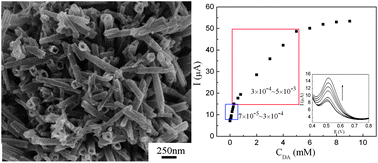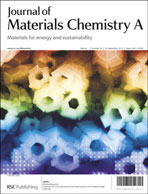Self-degradable template synthesis of polyaniline nanotubes and their high performance in the detection of dopamine
Abstract
Polyaniline (PANI) nanotubes with improved electrochemical activity were synthesized by using a self-degradable MnO2 template and were developed as electrode materials for biosensors. The morphology, composition, and optical properties of the resulting products were characterized by scanning electron microscopy (SEM), transmission electron microscopy (TEM), thermogravimetric analysis (TGA), Fourier transform infrared spectroscopy (FT-IR), and cyclic voltammetry (CV). The results confirmed that the obtained PANI nanotubes had a perfect tubular structure with uniform diameters and lengths. Furthermore, PANI nanotubes were immobilized onto the surface of a glassy carbon electrode (GCE) and applied to construct a sensor. The obtained PANI-modified GCE showed high catalytic activity in the electrochemical oxidation of dopamine (DA) in a near neutral environment. Differential pulse voltammogram (DPV) results illustrated that the fabricated DA biosensor had high anti-interference ability towards uric acid (UA), ascorbic acid (AA), and glucose (GC). In addition, the fabricated biosensor showed superior performance with two wide linear ranges from 7 × 10−5 to 3 × 10−4 M and 3 × 10−4 to 5 × 10−3 M with a lower limit of detection of 0.5 × 10−9 M.


 Please wait while we load your content...
Please wait while we load your content...